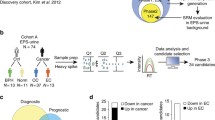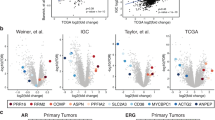Abstract
The ability to distinguish between aggressive and nonaggressive tumors has not changed despite vast improvements in the detection of prostate cancer (PCA). To improve predictive accuracy, additional PCA-specific biomarkers must be identified and it is the emerging microarray technology and gene expression profiling that appear to be capable of achieving this goal. Through comparisons of a number of published microarray studies of PCA, several potential biomarkers appear on the horizon, including the serine protease Hepsin, α-methylacyl CoA racemase, and the human homologue of the Drosophila protein Enhancer of Zeste. Although these markers will move toward validation by eventual protein expression studies, another aspect of microarray expression, global signature expression patterns through multidimensional scaling, appears to be promising in distinguishing between aggressive and nonaggressive forms of PCA or in distinguishing PCA from benign prostatic hyperplasia or normal prostate tissue.
Similar content being viewed by others
References and Recommended Reading
Jewett HJ: The present status of radical prostatectomy for stages A and B prostatic cancer. J Urol 1975, 2:105–124.
Gleason D: Classification of prostatic carcinomas. Cancer Chemother Rep 1966, 50:125–128.
Stamey TA, Yang N, Hay AR, et al.: Prostate-specific antigen as a serum marker for adenocarcinoma of the prostate. N Engl J Med 1987, 317:909–916.
Bertucci F, Viens P, Tagett R, et al.: DNA Arrays in clinical oncology: promises and challenges. Lab Invest 2003, 83:305–316.
Macgregor PF, Squire JA: Application of microarray to the analysis of gene expression in cancer. Clin Chem 2002, 48:1170–1177.
Cole KA, Krizman DB, Emmert-Buck MR: The genetics of cancer: a 3D model. Nat Genet 1999, 21:38–41.
Best CJ, Leiva IM, Chuaqui RF, et al.: Molecular differentiation of high-and moderate-grade human prostate cancer by cDNA microarray analysis. Diagn Mol Pathol 2003, 12:63–70.
Whitney, AR, Diehn M, Popper SJ, et al.: Individuality and variation in gene expression patterns in human blood. Proc Natl Acad Sci USA 2003, 100:1896–1901.
Khan J, Wei JS, Ringer M, et al.: Classification and diagnostic prediction of cancers using gene expression profiling and artificial neural networks. Nat Med 2001, 7:673–679.
Tusher VG, Olkin IV, Chu G: Significance analysis of microarrays applied to the ionizing radiation response. Proc Natl Acad Sci USA 2001, 98:5116–5121.
Agarwal D, Chen T, Irby R, et al.: Osteopontin identified as lead marker of colon cancer progression, using pooled sample expression profiling. J Natl Cancer Inst 2002 94:513–521.
Luo J, Duggan DJ, Chen VD, et al.: Human prostate cancer and benign prostatic hyperplasia: molecular dissection by gene expression profiling. Can Res 2001, 61:4683–4688. This paper was the first to distinguish PCA from BPH by MOS and weighted gene analysis.
Dhanasekaran SM., Barrette TR, Ghosh D, et al.: Delineation of prognostic biomarkers in prostate cancer. Nature 2001, 412:822–826. One of the first and most comprehensive studies of MET, PCA, prostatitis, BPH, and NAP by microarray expression analysis.
Magee JA, Araki T, Patil S, et al.: Expression profiling reveals hepsin overexpression in prostate cancer. Can Res 2001, 61:5692–5696.
Chetcuti A, Margan S, Mann S, et al.: Identification of differentially expressed genes in organ-confined prostate cancer by gene expression array. Prostate 2001, 47:132–140.
Welsh JB, Sapinoso LM, Su AI, et al.: Analysis of gene expression identifies candidate markers and pharmacological targets in prostate cancer. Can Res 2001, 61:5974–5978.
Ernst T, Hergenhahn M, Kenzelman M, et al.: Decrease and gain of gene expression are equally discriminatory markers for prostate carcinoma: a gene expression analysis on total and microdissected prostate tissue. Am J Pathol 2002, 160:2169–2180.
Bull JH, Ellison G, Patel A, et al.: Identification of potential diagnostic markers of prostate cancer and prostatic intraepithelial neoplasia using microarray. Br J Cancer 2001, 84:1512–1519.
Singh D, Febbo Pg, Ross K, et al.: Gene expression correlates of clinical prostate cancer behavior. Cancer Cell 2002, 1:203–209. This paper successfully shows that expression of a group of 29 genes by microarray analysis clustered according to Gleason score, but did not correlate with clinical outcome for prostate cancer.
Luo J, Yu YP, Cieply K, et al.: Gene expression analysis of prostate cancers. Mol Carcinog 2002, 33:25–35.
LaTulippe E, Satagopan J, Smith A, et al.: Comprehensive gene expression analysis of prostate cancer reveals distinct transcriptional programs associated with metastatic disease. Can Res 2002, 62:4499–4506.
Rhodes DR, Barrette TR, Rubin MA, et al.: Meta-analysis of microarrays: interstudy validation of gene expression profiles reveals pathway dysregulation in prostate cancer. Can Res 2002, 62:4427–4433. This is the first paper that has attempted to establish a statistical metaanalysis model for cross-validating data from four independent microarray experiments on the expression of genes in prostate cancer.
Ferdinandusse S, Denis S, Clayton PT: Mutations in the gene encoding peroxisomal alpha-methylacyl-CoA racemase cause adult-onset sensory motor neuropathy. Nat Gen 2000, 24:188–191.
Raaphorst FM, van Kemenade FJ, Blokzijl T, et al.: Coexpression of BM-1 and EZH2 polycomb group genes in Reed-Sternberg cells of Hodgkin’s disease. Am J Pathol 2000, 157:709–715.
van Lohuizen M, Verbeek S, Scheijen B, et al.: Identification of cooperating oncogenes in Eu-myc transgenic mice by provirus tagging. Cell 1991, 65:737–752.
Haupt Y, Alexander WS, Barri G, et al.: Novel zinc finger gene implicated as myc collaborator by retrovirally accelerated lymphomagenesis in Eu-myc transgenic mice. Cell 1991, 65:753–763.
Varambally S, Dhanasekaran SM, Zhou M, et al.: The polycomb group protein EZH2 is involved in progression of prostate cancer. Nature 2002, 419:624–629.
Shimizu K, Nagamachi Y, Tani M, et al.: Molecular cloning of a novel NF2/ERM/4.1 superfamily gene, EHM2, that is expressed in high-metastatic K1735 murine melanoma cells. Genomics 2000, 65:113–120.
Shurbaji MS, Kalbfleisch JH, Thurmond TS: Immunohistochemical detection of a fatty acid synthase (OA-519) as a predictor of progression of prostate cancer. Hum Pathol 1996, 27:917–921.
Rhodes DR, Sanda MG, Otte AP, et al.: Multiplex biomarker approach for determining risk of prostate-specific antigendefined recurrence of prostate cancer. J Natl Cancer Inst 2003, 95:661–668. An interesting paper that incorporates protein expression in the tissue microarray with attempts at combining candidate biomarkers. The results of this study suggest E-cadherin and EZH2 are significantly associated with PCA recurrence after radical prostatectomy.
Kattan MW: Judging new markers by their ability to improve predictive accuracy. J Natl Cancer Inst 2003, 95:634–635.
Magrath I: Molecular characteristics of diffuse large-b-cell lymphoma. N Engl J Med 2002, 346:1998–1999.
Rosenwald A, Wright G, Chan WC, et al.: The use of molecular profiling to predict survival after chemotherapy for diffuse large-b-cell lymphoma. N Engl J Med 2003, 346:1937–1947.
vande Vijver MJ, He YD, van’t Veer LJ, et al.: A gene-expression signature as a predictor of survival in breast cancer. N Engl J Med 2002, 347:1999–2009.
Nielsen TO, West RB, Linn SC, et al.: Molecular characterization of soft tissue tumors: a gene expression study. Lancet 2002, 359:1301–1307.
Khan J, Simon R, Bittner M, et al.: Gene expression profiling of alveolar rhabdomyosarcoma with cDNA arrays. Cancer Res 1998, 58:5009–5010.
Author information
Authors and Affiliations
Rights and permissions
About this article
Cite this article
Huppi, K., Chandramouli, G.V.R. Molecular profiling of prostate cancer. Curr Urol Rep 5, 45–51 (2004). https://doi.org/10.1007/s11934-004-0011-0
Issue Date:
DOI: https://doi.org/10.1007/s11934-004-0011-0




